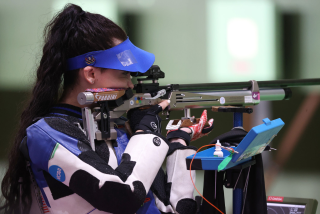COMMENTARY : Shooting the Works for $100 an Hour
- Share via
It puzzles Jerry Meyer that Americans who play golf or tennis happily hire instructors to help with their swings, but shotgunners act as if their skill should come from on high, uncluttered by professional intervention.
It’s not so the world around. About 200 shooting schools operate in England alone, says Meyer, a shooting instructor for Beretta U.S.A. and the British gunmaker Holland & Holland. On this side of the Atlantic, he said, “I don’t think I could name 12.”
Meyer saw opportunity lurking there, so a year ago he dumped his day job and three-piece suits to launch a full-time career teaching people to shoot clay pigeons and, by extension, gamebirds.
“I work every weekend,” said the tobacco-chewing skeet and sporting-clays expert, who flew in from Talking Rock, Ga., last weekend to train Washington area nimrods one-on-one at $100 an hour at a clinic.
With Meyer looking down the barrel from behind me, I managed to blast my first 12 clay pigeons to powder. He put a finger to his lips, thought for a moment, then characterized what he’d witnessed this way:
“You can kill a cat by packing butter up his nose too, but that doesn’t mean it’s the best way.” So he fiddled with this and fiddled with that until I couldn’t hit a bull in the behind with a banjo, then together we reconstructed my tattered swing to the point where I could hit about three out of four targets and (most important) look stylish in the process.
“Keep at it,” Meyer hollered as he headed off to the next student “You’ll get it.”
I sure hope so. Only six weeks remain before dove season opens, which always is the most challenging wingshooting of the year. What a time to be tinkering!
The proximity of dove season should encourage all rusty wingshots to head for the skeet, trap or sporting-clays range at least once or twice over the next few weeks to reacquaint themselves with the finer points and frustrations of shotgunning.
“The two most common problems I see,” said Meyer, a former national skeet champion, “are inconsistency in mounting the gun to the shoulder and then the tendency to engineer the shot by aiming and calculating, rather than letting instinct take over.”
Meyer follows the Holland & Holland technique of instinctive shooting, and encourages most gunners to take two basic steps to improve their success rate:
--First, cock the back end of the gunstock just under the pectoral muscle at the leading edge of the armpit while waiting for a target to be launched. Maintaining that fixed ready position means the gun comes forward and up just a few inches to mount for firing at exactly the same spot on the shoulder every time.
--Second, point the index finger of the non-trigger hand down the length of the forestock and use it to track the target as it passes. That way, instead of aiming, the shooter is encouraged to point and swing through the target, which puts the shot out ahead of the bird.
Shotgun shooting, Meyer says, is no different from any other quick, instinctive sporting reflex. “A baseball player doesn’t think to himself, ‘I need 332 feet per second of bat speed at the time of impact.’ He adjusts instinctively.”
But to be able to make snap adjustments, batters need to start from the same point and keep to a practiced routine. Shooters can do the same, said Meyer, if they mount the gun precisely, point at the target and keep it moving till the shot string is out of the barrel.
If it all sounds simple, it is. That doesn’t mean it’s easy. Pointing and shooting tiny pellets at small, fast-flying targets is hard enough on the controlled playing field of a skeet range; throw in trees and brush, bad footing, snow or rain, fatigue, poor light and the element of surprise, and it’s a wonder how anyone ever hits anything.
Why do the English have so many shooting schools? Simple, said Meyer. Over there, guests to the fanciest partridge shoots are chosen in part on shooting ability. “If you can’t hit birds, you go to the bottom of the list,” he said.
More to Read
Sign up for Essential California
The most important California stories and recommendations in your inbox every morning.
You may occasionally receive promotional content from the Los Angeles Times.













